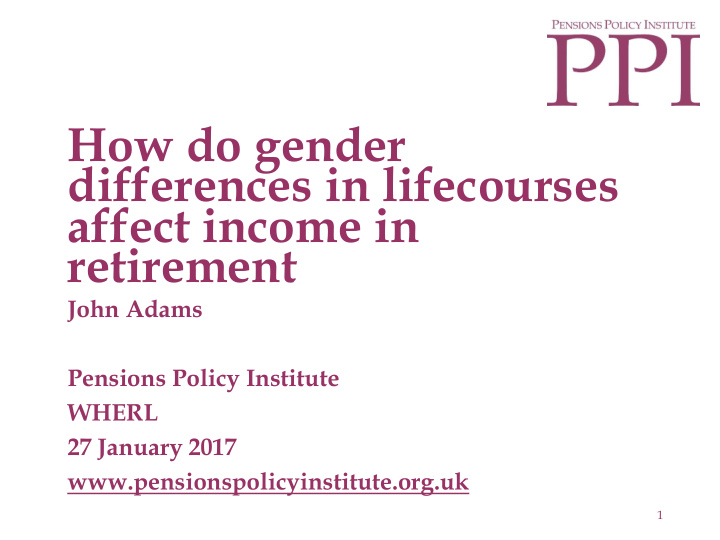



How do gender differences in lifecourses affect income in retirement John Adams Pensions Policy Institute WHERL 27 January 2017 www.pensionspolicyinstitute.org.uk 1
We’d like to thank...
Lifecourses The work-based lifecourses for men and women used in the modelling for this note Male Lifecourses Proportion (%) Mostly full-time throughout 45 Mostly non-employed throughout 4 Full-time, very early exit (at about age 49) 12 Full-time, early exit (at about age 60) 30 Late start (at about age 23), early exit (at about age 60) 9 Female Lifecourses Proportion (%) Mostly full-time throughout 27 Mostly non-employed throughout 17 Weak attachment, early exit (at about age 49) 7 Family carer to part-time (long break: 16 years) 12 Family carer to part time (short break: 4 years) 13 Family carer to full-time (10 year break) 18 Mostly part-time (from about age 23) 6
The most common female lifecourses show that women are more likely to have lower weekly income in retirement Weekly post retirement income at age 66 for individuals currently aged 55 earning at gender specific median earning level, under the three most common gender specific lifecourses (£ a week in 2016 earnings terms) State Pension Private Pension Other £350.00 Net £285.42 £300.00 Net £277.31 Net £255.41 Net £249.79 £250.00 Net £229.97 £122.49 £112.35 £95.55 £87.00 £200.00 £69.55 Net £164.81 £150.00 £100.00 £178.60 £169.55 £178.60 £162.23 £168.03 £162.23 £50.00 £0.00 -£50.00 Mostly full- Full-time, very Full-time, Mostly full- Mostly non- Family carer time early exit (49) early exit (60) time employed to full-time (10 throughout throughout throughout year break) Men Women
Differences in earnings of men and women may result in women having lower retirement income Weekly post retirement income at age 66 for individuals currently aged 55 earning at the 30th, 50th, and 70th percentile levels (£ a week in 2016 earnings terms) State Pension Private Pension Other £350.00 Net £329.00 £300.00 Net £288.26 Net £285.42 Net £255.14 Net £255.41 £250.00 £161.96 Net £232.40 £122.49 £126.10 £95.03 £95.55 £200.00 £72.59 £150.00 £100.00 £193.61 £178.60 £178.55 £168.21 £162.23 £168.03 £50.00 £0.00 -£50.00 30th percentile Median 70th percentile30th percentile Median 70th percentile Men mostly full-time throughout Women mostly full-time throughout
Gender differences in retirement ages under the previous pension system could mean lower retirement incomes for older women Weekly post retirement income at age 66 for median earning individuals currently aged 55, 60 and 65 (£ a week in 2016 earnings terms) State Pension Private Pension Other £350.00 Net £298.16 Net £295.92 Net £285.42 £300.00 Net £258.82 Net £255.41 Net £234.90 £250.00 £103.12 £122.01 £122.49 £92.62 £51.11 £95.55 £200.00 £150.00 £100.00 £212.26 £186.45 £191.40 £174.42 £178.60 £168.03 £50.00 £0.00 -£50.00 Age 55 Age 60 Age 65 Age 55 Age 60 Age 65 Men mostly full-time throughout Women mostly full-time throughout
Women taking breaks to look after children may lead to lower private pension income in retirement Weekly post retirement income at age 66 for median earning individuals currently aged 55 under various scenarios of caring for children (£ a week in 2016 earnings terms) State Pen Priv Pen Other (£3) £350 Net £286 £300 Net £256 £250 £122 Net £202 Net £187 Net £186 £96 £200 £37 £22 £21 £150 £100 £179 £162 £162 £162 £168 £50 £0 -£50 Male Full time No children, full 1 child, Short 2 children, Long 3 children late, throughout time throughout break (4 yrs) then break (16 yrs) Long break to part time then part time part time Women: motherhood penalty applied
Lower earning women taking breaks to look after children may be dependent on the State Pension Weekly post retirement income at age 66 for individuals currently aged 55, who earn at the 30th percentile level under various scenarios of caring for children (£ a week in 2016 earnings terms) State Pen Priv Pen Other (£3) £300 Net £255 £250 Net £232 Net £193 £95 £200 Net £182 Net £181 £73 £28 £17 £16 £150 £100 £162 £162 £162 £168 £162 £50 £0 -£50 Male Full time No children, full 1 child, Short 2 children, Long 3 children late, throughout time throughout break (4 yrs) then break (16 yrs) Long break to part time then part time part time Women: motherhood penalty applied
Conclusions • Gender differences in labour means tat more men have experienced being in full-time work throughout their careers and are therefore likely to have higher incomes in retirement. • Gender differences in earnings mean that women are more likely to have a lower income in retirement than a man even when their labour market history is similar. • The lower female State Pension age under the older system limited the amount of pension that could be built up leading to lower pensions for women (though paid earlier). • Women are more likely to have caring responsibilities than men, leading to lower private pensions.
Recommend
More recommend